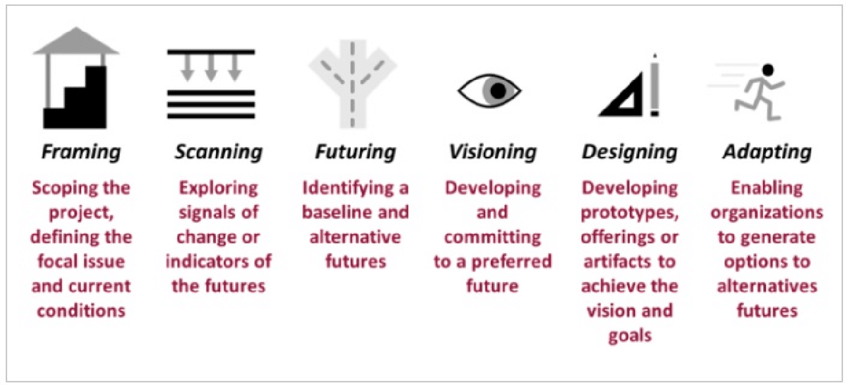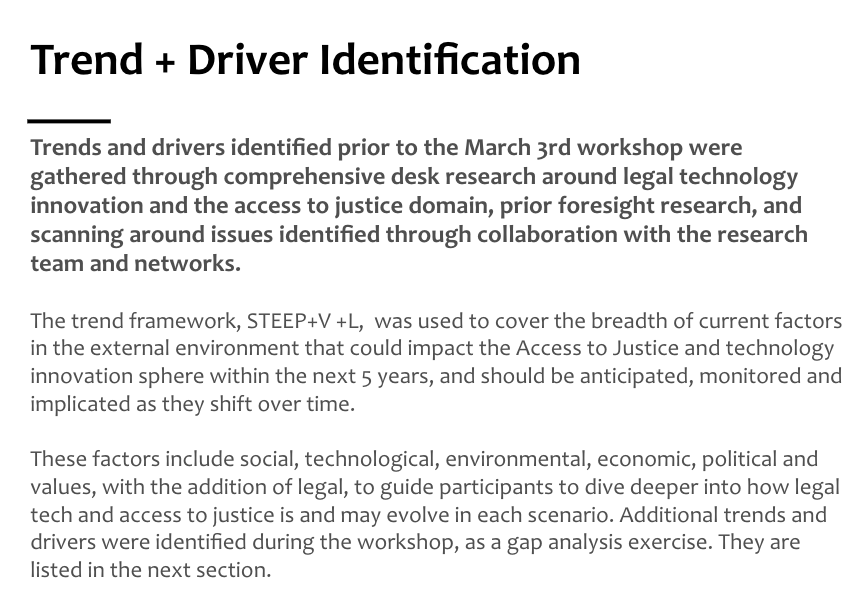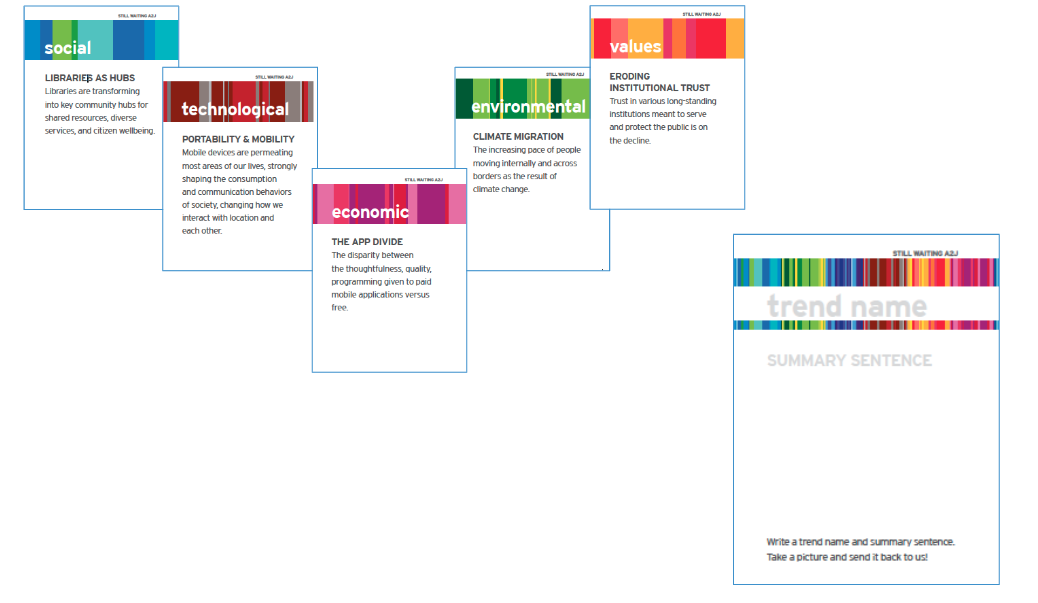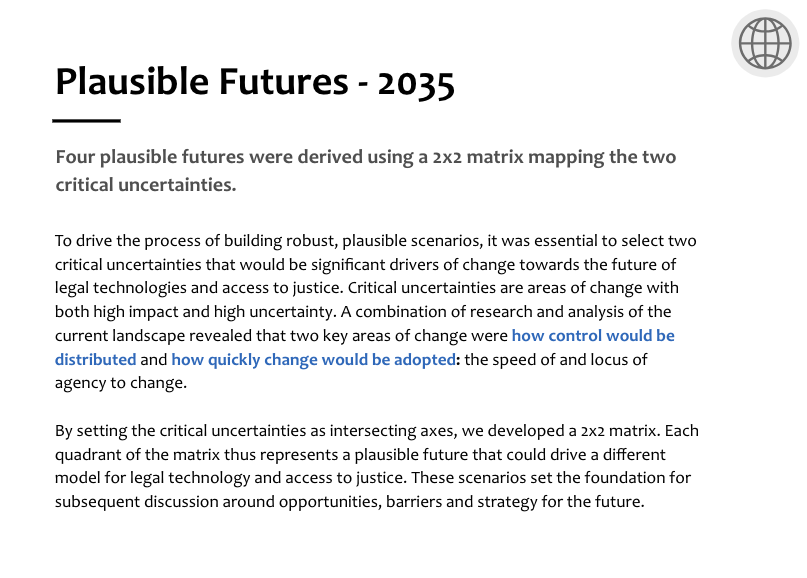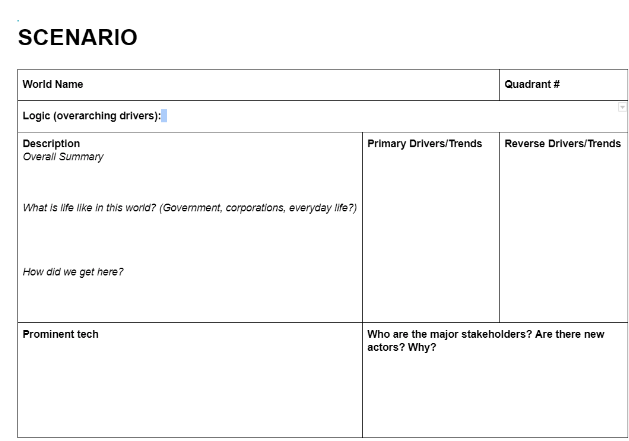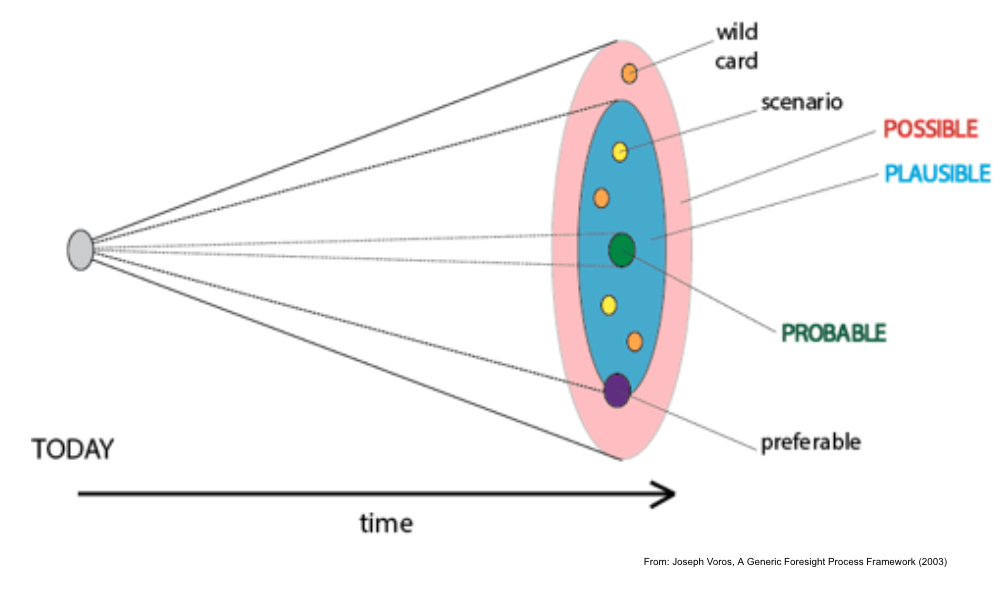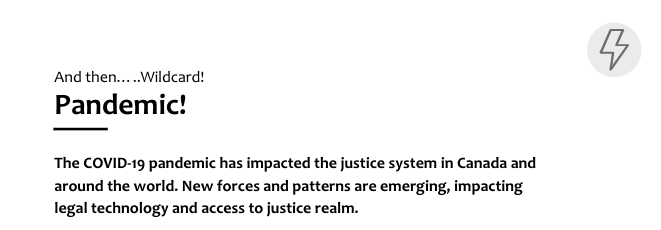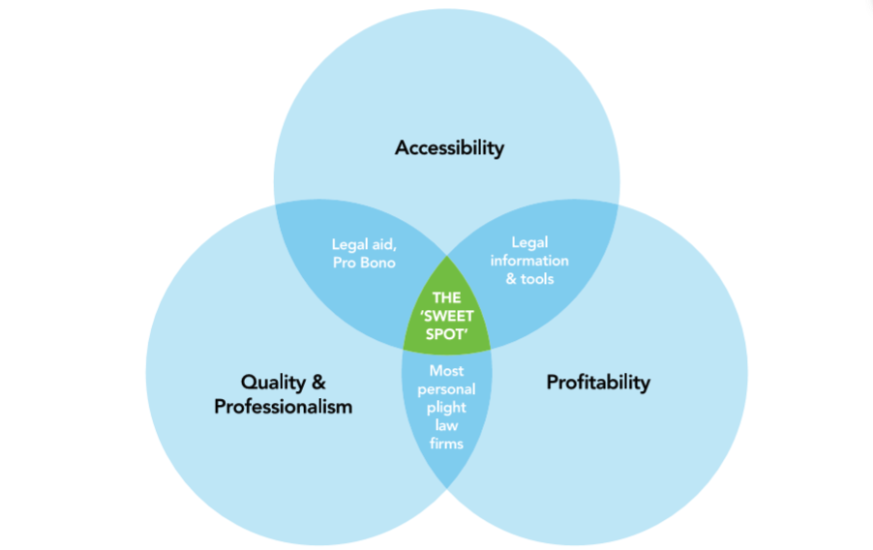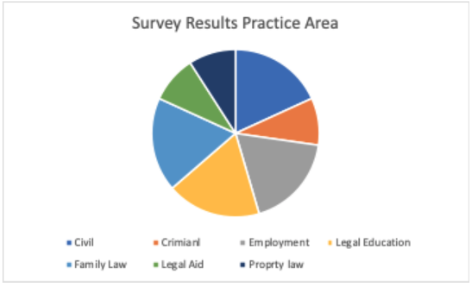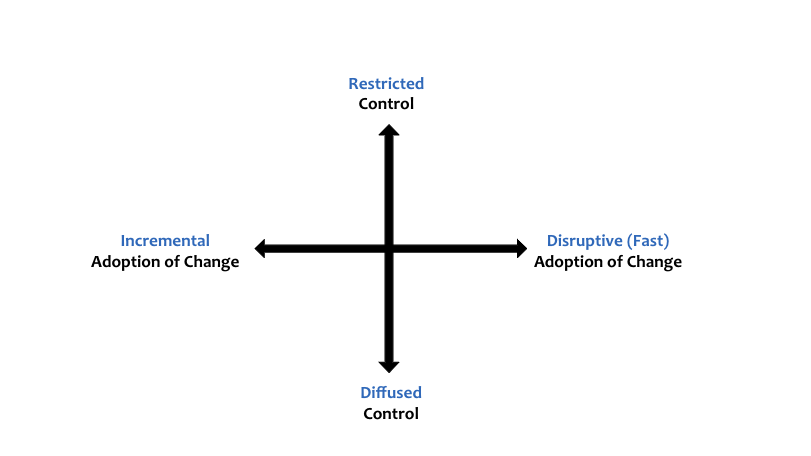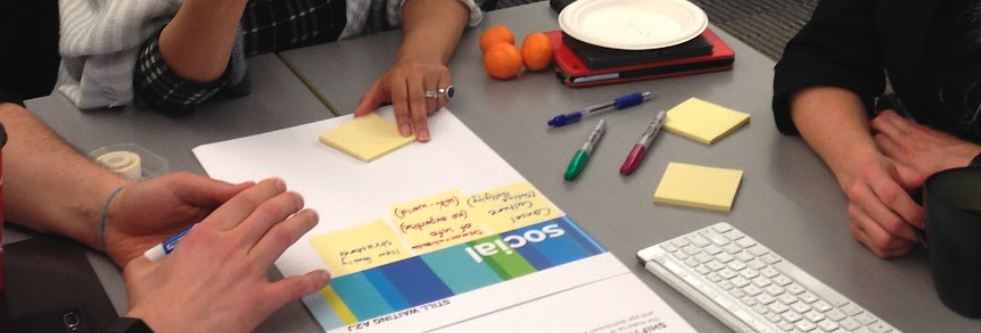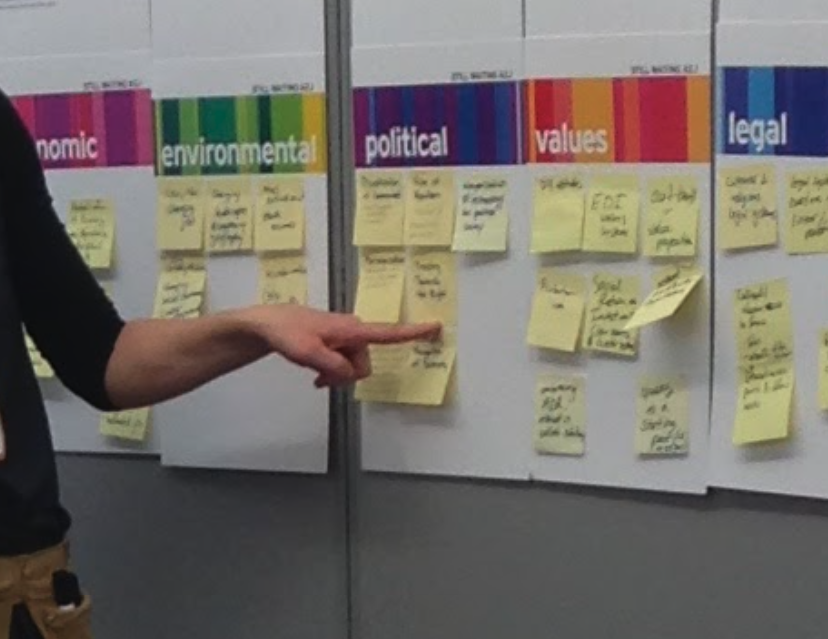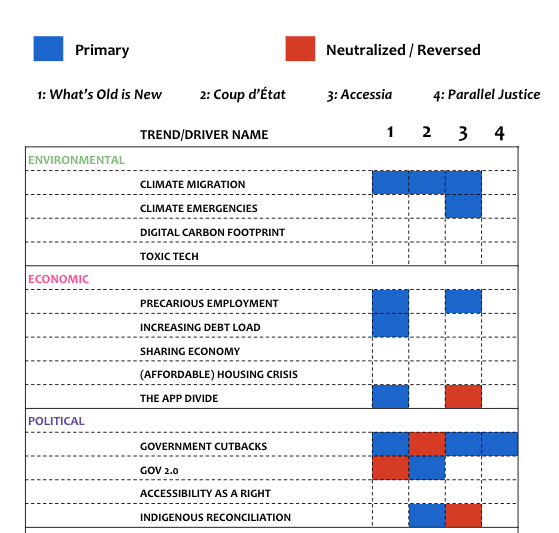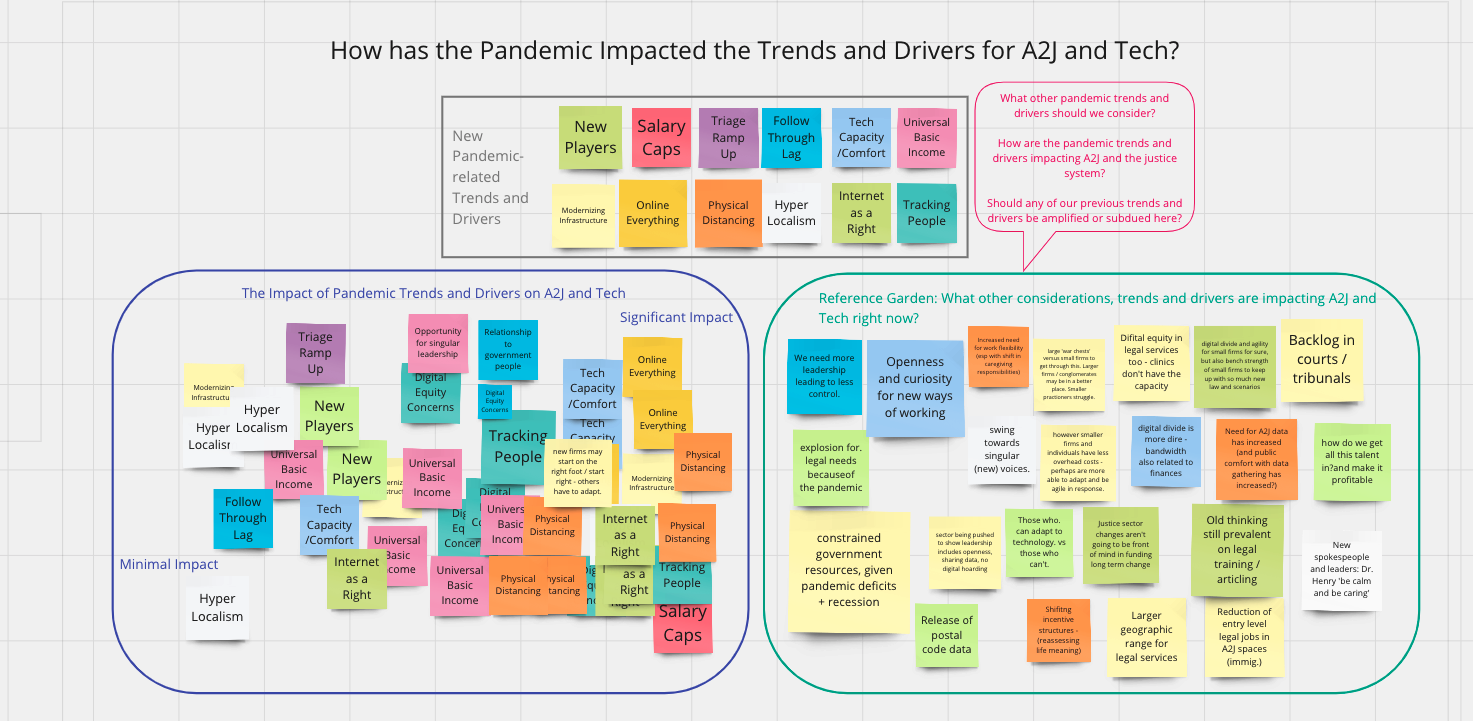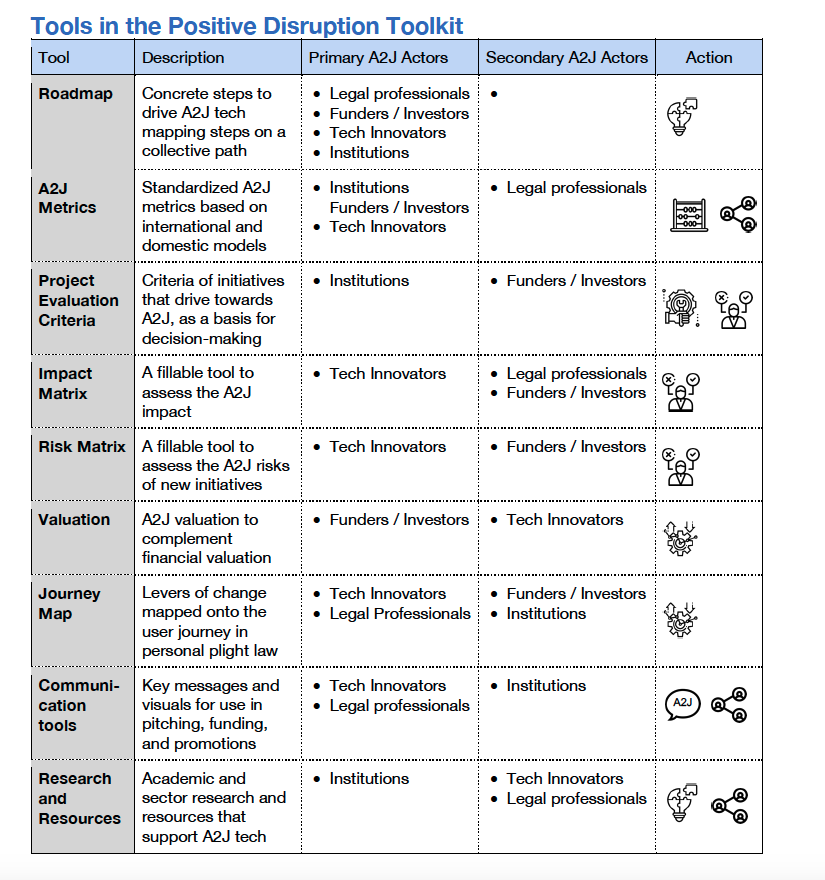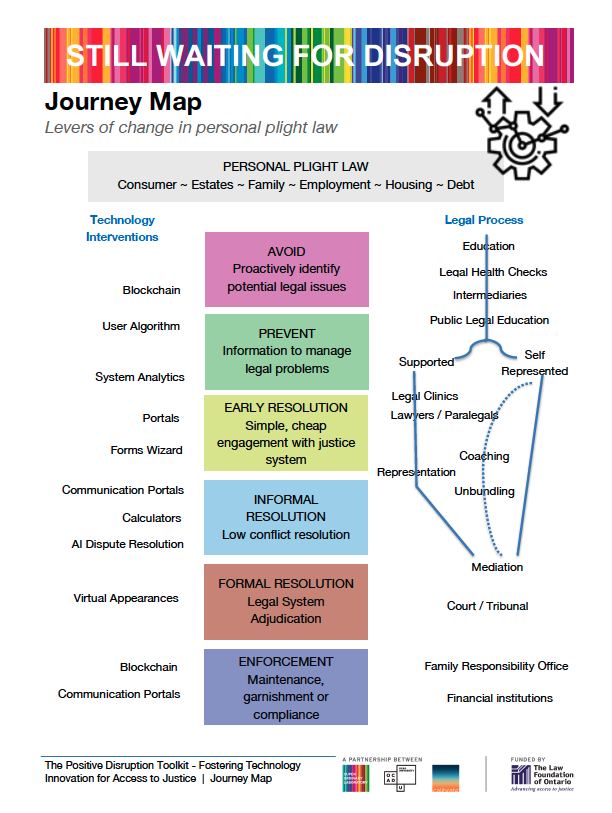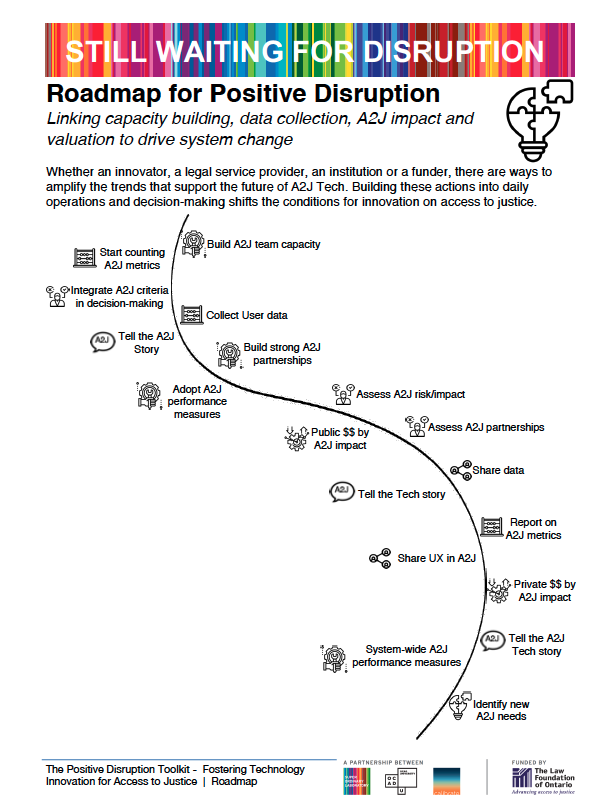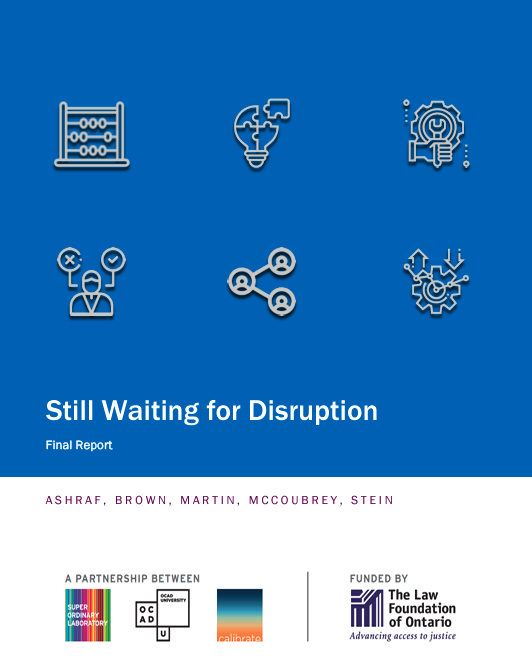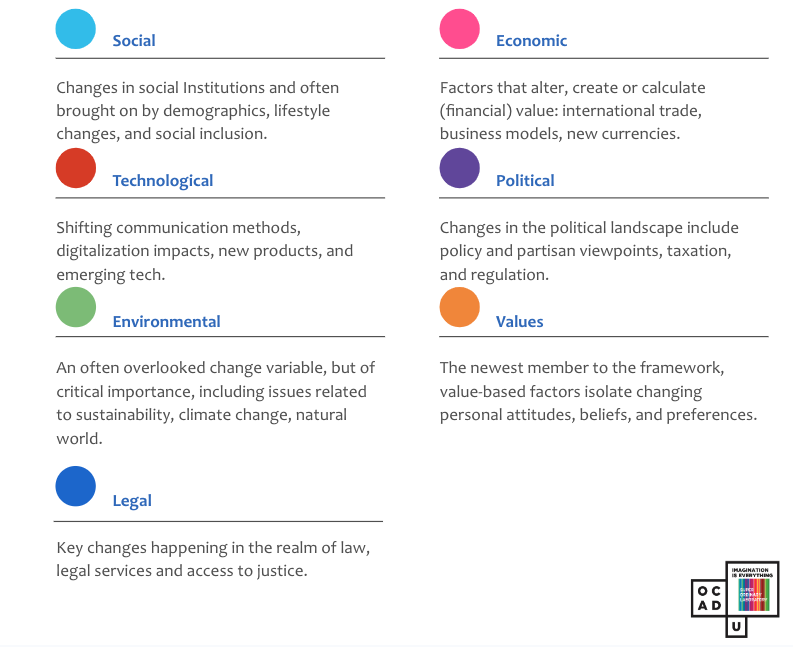Still Waiting for Disruption: Understanding Barriers to Access to Justice Technologies
My Role: Strategic Foresight and Innovation Researcher
Timeline: 1 Year
Objective: Exploring opportunities in legal technologies to foster Access to Justice for today and into the future. Legal technologies today are disrupting law firms and how they work, creating efficiencies, new services and new ways of working.
Introduction
The legal sector has witnessed significant technological innovation, particularly in areas such as lawyer work processes and decision-making applications. Tools ranging from customizable products to AI-supported legal analysis have become increasingly prevalent in law firms and corporate legal departments, transforming the way these functions operate. However, this technological disruption has not been equally felt in improving access to justice (A2J). While legal tech has enhanced lawyers' workflow and business models, it has not substantially improved people's experiences with justice or their access to legal conflict resolution.
The Still Waiting for Disruption (SWD) Project seeks to address this gap by advocating for a revised approach to legal tech disruption that prioritizes advancing access to justice. The project aims to highlight the value of positive legal tech impact on the access to justice crisis in Canada. It does so by exploring existing barriers to innovation and proposing future models that provide guidance for stakeholders such as A2J actors, tech innovators, and funders/investors. Through this initiative, the project seeks to drive meaningful change in how legal technology is developed and implemented to ensure it benefits everyone in accessing justice.
Our foresight challenge was to:
The goal of this project is to open up new opportunities for positive legal tech impact on the access to justice crisis in Canada, by exploring the existing barriers to innovative entrepreneurship and building future models that support increased access to legal conflict resolution.
How do you disrupt A2J tech?
Project Road Map
My Role:
I spearheaded comprehensive environmental scanning and literature review efforts to uncover emerging trends in Canada's legal landscape.
Applying the STEEP+ V+L model, I distilled collected data into actionable insights, guiding strategic decision-making.
I orchestrated 3 in-person and 2 online strategic foresight workshops, engaging major stakeholders through innovative facilitation techniques.
Crafting and analyzing targeted surveys for 5 stakeholder groups, I derived valuable insights to drive project direction.
Demonstrating my technical prowess, I personally coded and maintained a research website, ensuring seamless accessibility to project resources.
Collaborating closely with the team, I led brainstorming sessions and prototyped legal tools and frameworks, empowering stakeholders in innovation and access to justice.
Co-authoring a groundbreaking research paper endorsed by the Law Foundation of Ontario, I advocated for a nuanced approach to legal innovation within a futures framework.
What is Strategic Foresight and Futures Thinking? A look at the process.
Strategic foresight is a methodical approach to anticipating and preparing for future opportunities and challenges. It involves analyzing trends, gathering insights, and envisioning potential scenarios to inform decision-making and strategy development.
Innovation, on the other hand, is about introducing new ideas, products, or processes that create value and drive positive change. It involves creativity, problem-solving, and a willingness to challenge the status quo.
When we talk about "strategic foresight and innovation," we're highlighting the importance of forward-thinking and creativity in driving organizational growth and success. It's about being proactive in anticipating future trends and seizing opportunities to innovate and stay ahead of the curve.
Research Stages:
In this research project, we applied the discipline of Strategic Foresight to bring new thinking to entrenched, complex access to justice challenges, to help imagine new approaches to system change. Strategic foresight, combined with system and subject matter expertise has successfully been applied to advance projects in health, education and government sectors. It is commonly used across disciplines to understand the impact technological disruption will have in possible futures and to guide policy and planning to mitigate risk and increase the success in each future scenario, of environmental tensions and changes.
We used a variety of complementary and integrated research approaches, through several stages, in order to address the core areas of enquiry. These components included the following:
Literature review of A2J and technology research
Surveys including legal professionals, as well as intermediaries, Self Represented Litigants (End Users), and tech entrepreneurs.
Strategic foresight workshop with A2J actors, legal professionals and tech entrepreneurs
Workshop - Pandemic impact assessment and pragmatic tools review with members of our advisory council, A2J actors, legal professionals and tech entrepreneurs
Culminating in a:
Virtual symposium to present our findings and tools for a broader audience - including lawyers, law school students, tech entrepreneurs, and investors.
Literature review and surveys informed horizon scanning
Identified Trends: recent patterns likely to impact the next five years
Identified Drivers: longer-term forces shaping assumptions about the future
Workshops explored interactions of Trends and Drivers in scenarios addressing justice system tensions
Adapted to COVID, hosting a new workshop focused on its impact
Assessed desirability of proposed tools for navigating forward
FRAMING
Literature Review, Desk Research, Stakeholder Research
Cost: Legal technology solutions can sometimes be expensive to develop and implement, making them inaccessible to those who need them most, such as low-income individuals or small organizations.
Complexity: Legal processes can be complex and vary significantly depending on jurisdiction. Technology solutions must be intuitive and easy to use for people without legal expertise to benefit fully.
Regulatory Hurdles: The legal profession is heavily regulated, which can create barriers to the adoption of new technologies. Ensuring compliance with existing regulations while also pushing for regulatory changes to accommodate innovative solutions can be challenging.
Digital Divide: Not everyone has equal access to technology or the internet. This digital divide can exacerbate inequalities in access to justice if certain groups are left behind.
Resistance to Change: Like any industry, the legal profession can be resistant to change. Lawyers may be hesitant to adopt new technologies that could disrupt traditional ways of practicing law.
Privacy and Security Concerns: Legal matters often involve sensitive information, so ensuring the privacy and security of data transmitted and stored by legal technology solutions is paramount.
Lack of Awareness: Many people may not be aware of the legal technology solutions available to them or how these tools can help with their legal needs.
Surveys
I was in charge of conducting and analyzing 150+ surveys
Surveys were conducted with four different constituent groups during October 2019 through January 2020. We looked at the larger field of the legal stakeholders and focused on 4 categories of A2J actors. In order to understand the current conditions from data we wanted to draw out a picture on how these actors interact with each other. Our goal was to identify trends which were emerging and to extract key statistics and data. In doing so we were able to identify key trends, opportunities and challenges within the legal sector.
Self-Represented Litigants (SRL’s) and the Public Users
Legal Professionals
Intermediaries
Legal Tech Innovators
SCANNING
FUTURING
Futures Cone
The futures cone is a visual tool used in futures studies to depict the range of possible future outcomes. It starts wide at the present and narrows towards the distant future, illustrating increasing uncertainty over time. Different trajectories within the cone represent alternative futures based on various factors and events. By considering multiple scenarios, stakeholders can better navigate future uncertainties and make informed decisions.
a vision to mobilize multiple organizations towards attaining and maintaining a more equitable justice system, may serve to navigate us through. A prefered future, which multiple organizations strive for will help align efforts.
For the purposes of this project, the prefered Vision statement was:
[a future where] people are equitably supported (able) to prevent, avert and resolve conflicts equitably/fairly.
Horizon Scan
The three horizon scan is a strategic foresight framework used to analyze trends, innovations, and potential disruptions across different time horizons. It divides future developments into three main categories or "horizons":
Horizon 1 (H1): This horizon represents the current state and focuses on managing and optimizing existing operations and strategies. It involves monitoring ongoing trends and developments in the present environment.
Horizon 2 (H2): Horizon 2 looks at emerging trends and innovations that are likely to impact the organization in the medium term, typically spanning 1 to 3 years into the future. It involves exploring new opportunities and adapting strategies to capitalize on these emerging trends.
Horizon 3 (H3): Horizon 3 involves scanning for potential disruptions and transformative changes that may occur in the distant future, usually beyond 3 years. It focuses on identifying potential risks and opportunities arising from emerging technologies, societal shifts, or other external factors.
VISIONING
We gathered and analyzed all our data against the frameworks of the futures cone and the Horizon scan to come up with a 2x2 matrix to build out possible worlds.
Our workshop took place a week before thee world shut down due to the Pandemic Covid-19
After our workshop, we gathered all the valuable data we collected, including notes, recordings, and survey responses. We then organized this information to make it easier to analyze, grouping it by themes and topics. Our team carefully went through the qualitative data, applying coding techniques to identify patterns and key points from our discussions. Simultaneously, we delved into the quantitative data, running statistical analyses to uncover trends and correlations. From this feedback, we began designing tools and frameworks to address the identified needs and challenges.
Gathered workshop data, including notes, recordings, and survey responses.
Organized data by themes and topics for easier analysis.
Applied coding techniques to qualitative data and conducted statistical analysis on quantitative data.
Synthesized findings from both qualitative and quantitative analyses.
Identified recurring themes and emerging trends.
Engaged in sensemaking to interpret implications within organizational context.
Created visualizations (charts, graphs) for clearer presentation of insights.
Prepared comprehensive report and presentation summarizing key findings and recommendations.
Collaborated as a team to ensure meaningful insights and actionable strategies.
DESIGNING
Workshop 2-Online
1
To understand the impact of the pandemic on the analysis through:
Considering developing pandemic trends and drivers and how they impact the current state of the justice system, and
Reflecting on how the pandemic has shifted the current reality in terms of the axes of control and adoption of change
2
Workshop 1-In Person
Trends and Drivers
To ensure understanding and validate the work of the project by:
Reviewing the outcomes and outputs for the project,
Sharing preliminary findings, and
Discussing the contents of the toolkit.
The next stage of the research process was a virtual workshop. Originally, a full interactive symposium had been planned, but as a result of the COVID-19 pandemic that started during the spring research phase, the project pivoted to a smaller virtual workshop to be followed by a virtual symposium. This workshop included past foresight workshop participants and a few new participants.
This virtual workshop, held on May 28, 2020, had a two-fold purpose:
ADAPTING
Toolkit for Action
The toolkit that we have developed is meant to help foment current actions, and guide us collectively forward. Its tools are based on actions to support positive forces of change and to counteract those that would deter us from achieving better A2J. We look to change that will to move us out of the current scenario of tight controls and little adoption into a concerted opening up of the potential for innovation in the A2J space that would serve End Users, including SRLs, as well as the intermediaries and legal professionals that support them.
Drawing on the comparison of scenarios in the foresight process, it became clear that several trends were most important to focus on in order to drive forward the level of innovation needed. These are the differences that would make a difference. In some cases, trends may be manifestly different in nature, but would demand the same or similar response in upholding (amplifying) them or counteracting (subduing) them.
By keeping these in focus, it will make it easier to assess the potential A2J impact of new initiatives:
Trends to amplify ….
Better integration with an increasingly digital life
Increased avenues for digital advocacy and activism
Improved portability and mobility
Supporting a more open legal profession
Trends to subdue…..
Reduce the app divide
Decrease the IT poverty loop
Increase access to data
Project Conclusion
Virtual Symposium: The Soft Launch
The virtual symposium, held on June 11, in a webinar style, was designed to share the key findings from the research, and to ‘soft launch’ the toolkit. The Symposium was in collaboration with the Law Foundation of Ontario attended by all the legal field. stakeholders.
Final Report
As a co-author with my team, I contributed to publishing a groundbreaking 90-page research report, the first of its kind in applying futures thinking for the Law Foundation. Our findings were disseminated across the legal community of Ontario, marking a significant milestone in advancing strategic foresight within the legal sector. For the full report click here.




